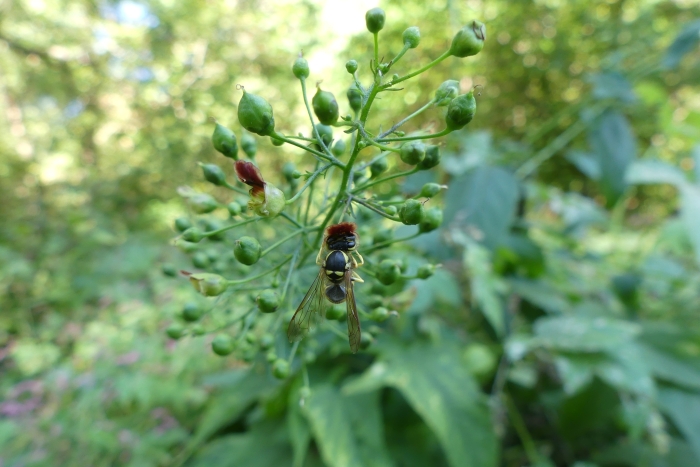Carpenter’s Square
(Scrophularia marilandica)
Carpenter’s Square (Scrophularia marilandica)
/
/

botanygirl
CC BY 4.0
Image By:
botanygirl
Recorded By:
Copyright:
CC BY 4.0
Copyright Notice:
Photo by: botanygirl | License Type: CC BY 4.0 | License URL: http://creativecommons.org/licenses/by/4.0/ | Rights Holder: botanygirl | Publisher: iNaturalist | Date Created: 2019-10-11T15:10:43-07:00 |





















































Estimated Native Range
Summary
Scrophularia marilandica, commonly known as Carpenter’s Square, is a semi-deciduous perennial herb native to moist woodlands, stream banks, and thickets in the Central and Eastern USA, extending into Manitoba. It typically grows 1.5–3 meters (4 ft 11 in – 9 ft 10 in) tall, with a square stem that gives the plant its common name. The foliage is coarse, with opposite, ovate leaves that have a toothed margin. The unique flowers, which bloom from late summer to early fall, are small, rounded, and 8–9 millimeters (0.31–0.35 in) long. They feature a peculiar cup-like mouth, resembling a horse’s mouth with a pronounced overbite, and are a deep reddish-purple inside, with a greenish to almost brown exterior. These flowers are not particularly showy but are known for attracting hummingbirds and supporting a variety of insects.
Carpenter’s Square is valued for its wildlife benefits, particularly for attracting pollinators like hummingbirds and beneficial insects. It is used in naturalized plantings, wildlife gardens, and as a border plant in moist areas. It thrives in full sun to part shade and requires medium amounts of water, adapting well to a range of soil drainage conditions from slow to fast. While not commonly afflicted by diseases, it can occasionally suffer from rust or leaf spot. This plant is not typically invasive but can spread by seed if conditions are favorable.CC BY-SA 4.0
Carpenter’s Square is valued for its wildlife benefits, particularly for attracting pollinators like hummingbirds and beneficial insects. It is used in naturalized plantings, wildlife gardens, and as a border plant in moist areas. It thrives in full sun to part shade and requires medium amounts of water, adapting well to a range of soil drainage conditions from slow to fast. While not commonly afflicted by diseases, it can occasionally suffer from rust or leaf spot. This plant is not typically invasive but can spread by seed if conditions are favorable.CC BY-SA 4.0
Plant Description
- Plant Type: Herb
- Height: 5-10 feet
- Width: 3-6 feet
- Growth Rate: Rapid
- Flower Color: N/A
- Flowering Season: Summer, Fall
- Leaf Retention: Deciduous
Growth Requirements
- Sun: Full Sun, Part Shade
- Water: Medium
- Drainage: Fast, Medium, Slow
Common Uses
Bee Garden, Bird Garden, Butterfly Garden, Hummingbird Garden, Low Maintenance
Natural Habitat
Moist woodlands, stream banks, and thickets
Other Names
Common Names: Figwort , Carpenter’s-Square , Eastern Figwort , Late Figwort , Maryland Figwort
Scientific Names: Scrophularia marilandica , Scrophularia neglecta , Scrophularia nodosa var. marilandica , Scrophularia marilandica var. viridis , Scrophularia adenopa , Scrophularia diversifolia , Scrophularia nodosa var. americana , Scrophularia serrulata
GBIF Accepted Name: Scrophularia marilandica L.